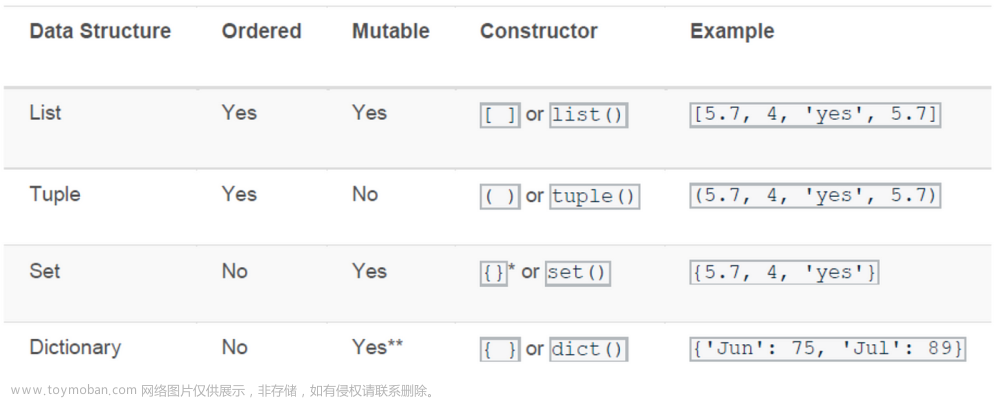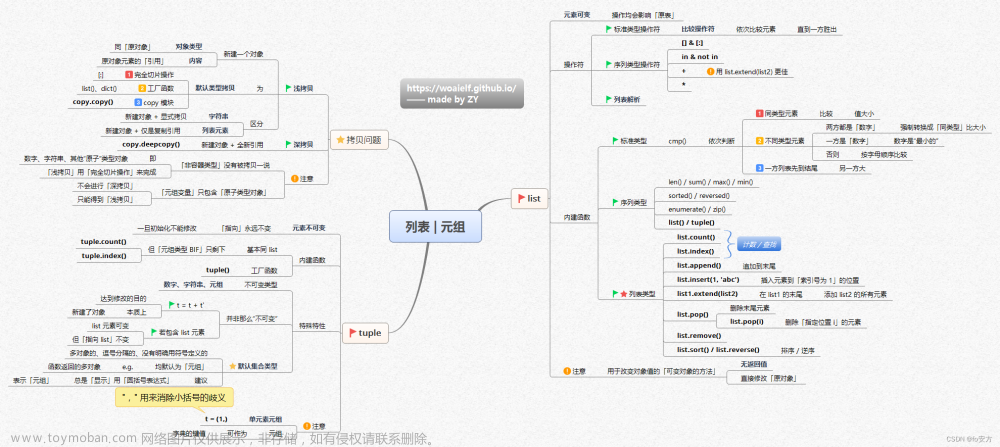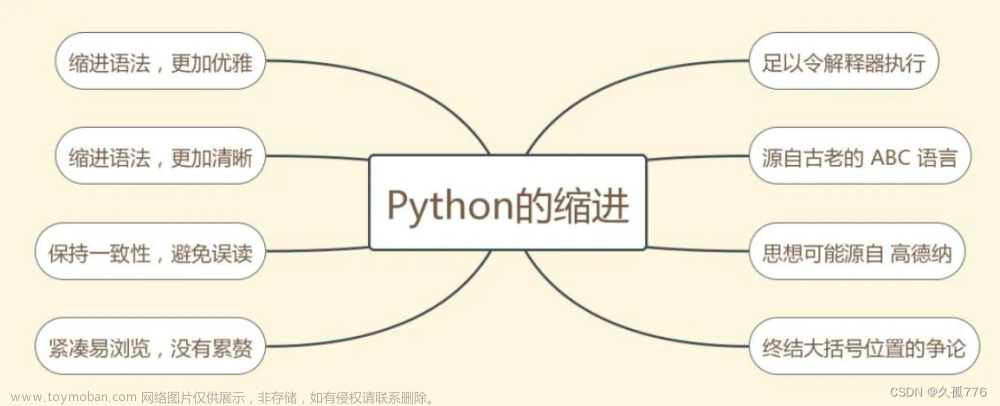一、字符串
一. 认识字符串
字符串是 Python 中最常用的数据类型。我们一般使用引号来创建字符串。创建字符串很简单,只要为变量分配一个值即可。
a = 'hello world'
print(type(a))
注意:控制台显示结果为
<class 'str'>, 即数据类型为str(字符串)。
1.1 字符串特征
- 一对引号字符串
name = 'Frank'
name = " 二狗 "
- 三引号字符串
name = ''' Frank '''
name = """ 二狗 """
注意:三引号形式的字符串支持换行。
思考:如果创建一个字符串
I'm Frank?
c = "I'm Frank"
d = 'I\'m Frank' # \' 在单引号字符中表示 '
1.2 字符串输出
print('hello world')
name = 'Frank'
print('我的名字是%s' % Frank)
print(f'我的名字是{Frank}')
1.3 字符串输入
在Python中,使用input()接收用户输入。
- 代码
name = input('请输入您的名字:')
print(f'您输入的名字是{name}')
print(type(name))
password = input('请输入您的密码:')
print(f'您输入的密码是{password}')
print(type(password))
二、下标
“下标”又叫“索引”,就是编号。下标的作用即是通过下标快速找到对应的数据。
2.1 快速体验
需求:字符串name = "abcdef",取到不同下标对应的数据。
name = "abcdef"
print(name[1]) #b
print(name[0]) #a
print(name[2]) #c
注意:下标从0开始。
三、切片
切片是指对操作的对象截取其中一部分的操作。字符串、列表、元组都支持切片操作。
3.1 语法
序列[开始位置下标:结束位置下标:步长]
注意
1. 不包含结束位置下标对应的数据, 正负整数均可;
2. 步长是选取间隔,正负整数均可,默认步长为1。
3. 开始下标可以省略不写,结束下标也可以不写,步长也可以省略
4. [开始位置下标:结束位置下标:步长)左开右闭区间
5. 负数表示从后向前遍历
3.2 体验
name = "abcdefg"
print(name[2:5:1]) # cde
print(name[2:5]) # cde
print(name[:5]) # abcde
print(name[1:]) # bcdefg
print(name[:]) # abcdefg
print(name[::2]) # aceg
print(name[:-1]) # abcdef, 负1表示倒数第一个数据
print(name[-4:-1]) # def
print(name[::-1]) # gfedcba
四、常用操作方法
字符串的常用操作方法有查找、修改和判断三大类。
4.1 查找
所谓字符串查找方法即是查找子串在字符串中的位置或出现的次数。
- find():检测某个子串是否包含在这个字符串中,如果在返回这个子串开始的位置下标,否则则返回-1。
- 语法
字符串序列.find(子串, 开始位置下标, 结束位置下标)
注意:开始和结束位置下标可以省略,表示在整个字符串序列中查找。
- 快速体验
mystr = "hello world and itcast and itheima and Python"
print(mystr.find('and')) # 12
print(mystr.find('and', 15, 30)) # 23
print(mystr.find('ands')) # -1
- index():检测某个子串是否包含在这个字符串中,如果在返回这个子串开始的位置下标,否则则报异常。
- 语法
字符串序列.index(子串, 开始位置下标, 结束位置下标)
注意:开始和结束位置下标可以省略,表示在整个字符串序列中查找。
- 快速体验
mystr = "hello world and itcast and itheima and Python"
print(mystr.index('and')) # 12
print(mystr.index('and', 15, 30)) # 23
print(mystr.index('ands')) # 报错
- rfind(): 和find()功能相同,但查找方向为右侧开始。
- rindex():和index()功能相同,但查找方向为右侧开始。
- count():返回某个子串在字符串中出现的次数
- 语法
字符串序列.count(子串, 开始位置下标, 结束位置下标)
注意:开始和结束位置下标可以省略,表示在整个字符串序列中查找。
- 快速体验
mystr = "hello world and itcast and itheima and Python"
print(mystr.count('and')) # 3
print(mystr.count('ands')) # 0
print(mystr.count('and', 0, 20)) # 1
4.2 修改
所谓修改字符串,指的就是通过函数的形式修改字符串中的数据。在基本操作前面加上 l 或者 r 表示遍历的顺序。
- replace():替换
- 语法
字符串序列.replace(旧子串, 新子串, 替换次数)
注意:替换次数如果查出子串出现次数,则替换次数为该子串出现次数。
- 快速体验
mystr = "hello world and itcast and itheima and Python"
# 结果:hello world he itcast he itheima he Python
print(mystr.replace('and', 'he'))
# 结果:hello world he itcast he itheima he Python
print(mystr.replace('and', 'he', 10))
# 结果:hello world and itcast and itheima and Python
print(mystr)
注意:数据按照是否能直接修改分为可变类型和不可变类型两种。字符串类型的数据修改的时候不能改变原有字符串,属于不能直接修改数据的类型即是不可变类型。
- split():按照指定字符分割字符串。
- 语法
字符串序列.split(分割字符, num)
注意:num表示的是分割字符出现的次数,即将来返回数据个数为num+1个。
- 快速体验
mystr = "hello world and itcast and itheima and Python"
# 结果:['hello world ', ' itcast ', ' itheima ', ' Python']
print(mystr.split('and'))
# 结果:['hello world ', ' itcast ', ' itheima and Python']
print(mystr.split('and', 2))
# 结果:['hello', 'world', 'and', 'itcast', 'and', 'itheima', 'and', 'Python']
print(mystr.split(' '))
# 结果:['hello', 'world', 'and itcast and itheima and Python']
print(mystr.split(' ', 2))
注意:如果分割字符是原有字符串中的子串,分割后则丢失该子串。
- join():用一个字符或子串合并字符串,即是将多个字符串合并为一个新的字符串。
- 语法
字符或子串.join(多字符串组成的序列)
- 快速体验
list1 = ['chuan', 'zhi', 'bo', 'ke']
t1 = ('aa', 'b', 'cc', 'ddd')
# 结果:chuan_zhi_bo_ke
print('_'.join(list1))
# 结果:aa...b...cc...ddd
print('...'.join(t1))
- capitalize():将字符串第一个字符转换成大写。
mystr = "hello world and itcast and itheima and Python"
# 结果:Hello world and itcast and itheima and python
print(mystr.capitalize())
注意:capitalize()函数转换后,只字符串第一个字符大写,其他的字符全都小写。
- title():将字符串每个单词首字母转换成大写。
mystr = "hello world and itcast and itheima and Python"
# 结果:Hello World And Itcast And Itheima And Python
print(mystr.title())
- lower():将字符串中大写转小写。
mystr = "hello world and itcast and itheima and Python"
# 结果:hello world and itcast and itheima and python
print(mystr.lower())
- upper():将字符串中小写转大写。
mystr = "hello world and itcast and itheima and Python"
# 结果:HELLO WORLD AND ITCAST AND ITHEIMA AND PYTHON
print(mystr.upper())
-
lstrip():删除字符串左侧空白字符。
-
rstrip():删除字符串右侧空白字符。
-
strip():删除字符串两侧空白字符。
-
ljust():返回一个原字符串左对齐,并使用指定字符(默认空格)填充至对应长度 的新字符串。
- 语法
字符串序列.ljust(长度, 填充字符)
- 输出效果
- rjust():返回一个原字符串右对齐,并使用指定字符(默认空格)填充至对应长度 的新字符串,语法和ljust()相同。
- center():返回一个原字符串居中对齐,并使用指定字符(默认空格)填充至对应长度 的新字符串,语法和ljust()相同。
4.3 判断
所谓判断即是判断真假,返回的结果是布尔型数据类型:True 或 False。
- startswith():检查字符串是否是以指定子串开头,是则返回 True,否则返回 False。如果设置开始和结束位置下标,则在指定范围内检查。
- 语法
字符串序列.startswith(子串, 开始位置下标, 结束位置下标)
- 快速体验
mystr = "hello world and itcast and itheima and Python "
# 结果:True
print(mystr.startswith('hello'))
# 结果False
print(mystr.startswith('hello', 5, 20))
- endswith()::检查字符串是否是以指定子串结尾,是则返回 True,否则返回 False。如果设置开始和结束位置下标,则在指定范围内检查。
- 语法
字符串序列.endswith(子串, 开始位置下标, 结束位置下标)
- 快速体验
mystr = "hello world and itcast and itheima and Python"
# 结果:True
print(mystr.endswith('Python'))
# 结果:False
print(mystr.endswith('python'))
# 结果:False
print(mystr.endswith('Python', 2, 20))
- isalpha():如果字符串至少有一个字符并且所有字符都是字母则返回 True, 否则返回 False。
mystr1 = 'hello'
mystr2 = 'hello12345'
# 结果:True
print(mystr1.isalpha())
# 结果:False
print(mystr2.isalpha())
- isdigit():如果字符串只包含数字则返回 True 否则返回 False。
mystr1 = 'aaa12345'
mystr2 = '12345'
# 结果: False
print(mystr1.isdigit())
# 结果:False
print(mystr2.isdigit())
- isalnum():如果字符串至少有一个字符并且所有字符都是字母或数字则返 回 True,否则返回 False。
mystr1 = 'aaa12345'
mystr2 = '12345-'
# 结果:True
print(mystr1.isalnum())
# 结果:False
print(mystr2.isalnum())
- isspace():如果字符串中只包含空白,则返回 True,否则返回 False。
mystr1 = '1 2 3 4 5'
mystr2 = ' '
# 结果:False
print(mystr1.isspace())
# 结果:True
print(mystr2.isspace())
二、列表
一. 列表
列表一次性可以存储多个数据。
二. 列表的格式
[数据1, 数据2, 数据3, 数据4......]
列表可以一次性存储多个数据,且可以为不同数据类型。
三. 列表的常用操作
列表的作用是一次性存储多个数据,程序员可以对这些数据进行的操作有:增、删、改、查。
3.1 查找
3.1.1 下标
name_list = ['ergou', 'maodan', 'frank']
print(name_list[0]) # ergou
print(name_list[1]) # maodan
print(name_list[2]) # frank
3.1.2 函数
- index():返回指定数据所在位置的下标 。
- 语法
列表序列.index(数据, 开始位置下标, 结束位置下标)
- 快速体验
name_list = ['ergou', 'maodan', 'frank']
print(name_list.index('ergou', 0, 2)) # 1
注意:如果查找的数据不存在则报错。
- count():统计指定数据在当前列表中出现的次数。
name_list = ['ergou', 'maodan', 'frank']
print(name_list.count('ergou')) # 1
- len():访问列表长度,即列表中数据的个数。
name_list = ['ergou', 'maodan', 'frank']
print(len(name_list)) # 3
3.1.3 判断是否存在
- in:判断指定数据在某个列表序列,如果在返回True,否则返回False
name_list = ['ergou', 'maodan', 'frank']
# 结果:True
print('ergou' in name_list)
# 结果:False
print('ErGou' in name_list)
- not in:判断指定数据不在某个列表序列,如果不在返回True,否则返回False
name_list = ['ergou', 'maodan', 'frank']
# 结果:False
print('ergo' not in name_list)
# 结果:True
print('ErGou' not in name_list)
- 体验案例
需求:查找用户输入的名字是否已经存在。
name_list = ['ergou', 'maodan', 'frank']
name = input('请输入您要搜索的名字:')
if name in name_list:
print(f'您输入的名字是{name}, 名字已经存在')
else:
print(f'您输入的名字是{name}, 名字不存在')
3.2 增加
作用:增加指定数据到列表中。
- append():列表结尾追加数据。
- 语法
列表序列.append(数据)
- 体验
name_list = ['ergou', 'maodan', 'frank']
name_list.append('xiaoming')
# 结果:['Tom', 'Lily', 'Rose', 'xiaoming']
print(name_list)
列表追加数据的时候,直接在原列表里面追加了指定数据,即修改了原列表,故列表为可变类型数据。
- 注意点
如果append()追加的数据是一个序列,则追加整个序列到列表
name_list = ['ergou', 'maodan', 'frank']
name_list.append(['xiaoming', 'xiaohong'])
# 结果:['ergou', 'maodan', 'frank', ['xiaoming', 'xiaohong']]
print(name_list)
- extend():列表结尾追加数据,如果数据是一个序列,则将这个序列的数据逐一添加到列表。
- 语法
列表序列.extend(数据)
-
快速体验
2.1 单个数据
name_list = ['ergou', 'maodan', 'frank']
name_list.extend('xiaoming')
# 结果:['ergou', 'maodan', 'frank', 'x', 'i', 'a', 'o', 'm', 'i', 'n', 'g']
print(name_list)
2.2 序列数据
name_list = ['ergou', 'maodan', 'frank']
name_list.extend(['xiaoming', 'xiaohong'])
# 结果:['ergou', 'maodan', 'frank', 'xiaoming', 'xiaohong']
print(name_list)
- insert():指定位置新增数据。
- 语法
列表序列.insert(位置下标, 数据)
- 快速体验
name_list = ['ergou', 'maodan', 'frank']
name_list.insert(1, 'xiaoming')
# 结果:['ergou', 'xiaoming', 'maodan', 'frank']
print(name_list)
3.3 删除
- del
- 语法
del 目标
-
快速体验
2.1 删除列表
name_list = ['ergou', 'maodan', 'frank']
# 结果:报错提示:name 'name_list' is not defined
del name_list
print(name_list)
2.2 删除指定数据
name_list = ['ergou', 'maodan', 'frank']
del name_list[0]
# 结果:['maodan', 'frank']
print(name_list)
- pop():删除指定下标的数据(默认为最后一个),并返回该数据。
列表序列.pop(下标)
- remove():移除列表中某个数据的第一个匹配项。
列表序列.remove(数据)
- clear():清空列表
3.4 修改
- 修改指定下标数据
name_list = ['ergou', 'maodan', 'frank']
name_list[0] = 'aaa'
# 结果:['aaa','maodan', 'frank']
print(name_list)
- 逆置:reverse()
num_list = [1, 5, 2, 3, 6, 8]
num_list.reverse()
# 结果:[8, 6, 3, 2, 5, 1]
print(num_list)
- 排序:sort()
- 语法
列表序列.sort( key=None, reverse=False)
注意:reverse表示排序规则,reverse = True 降序, reverse = False 升序(默认)
- 快速体验
num_list = [1, 5, 2, 3, 6, 8]
num_list.sort()
# 结果:[1, 2, 3, 5, 6, 8]
print(num_list)
3.5 复制
函数:copy()
name_list = ['ergou', 'maodan', 'frank']
name_li2 = name_list.copy()
name_list = ['ergou', 'maodan', 'frank']
print(name_li2)
四. 列表的循环遍历
需求:依次打印列表中的各个数据。
4.1 while
- 代码
name_list = ['ergou', 'maodan', 'frank']
i = 0
while i < len(name_list):
print(name_list[i])
i += 1
4.2 for
- 代码
name_list = ['Tom', 'Lily', 'Rose']
for i in name_list:
print(i)
五. 列表嵌套
所谓列表嵌套指的就是一个列表里面包含了其他的子列表。
应用场景:要存储班级一、二、三三个班级学生姓名,且每个班级的学生姓名在一个列表。
name_list = [['小明', '小红', '小绿'], ['Tom', 'Lily', 'Rose'], ['张三', '李四', '王五']]
思考: 如何查找到数据"李四"?
# 第一步:按下标查找到李四所在的列表
print(name_list[2])
# 第二步:从李四所在的列表里面,再按下标找到数据李四
print(name_list[2][1])
三、元组
一. 元组的应用场景
思考:如果想要存储多个数据,但是这些数据是不能修改的数据,怎么做?
答:列表?列表可以一次性存储多个数据,但是列表中的数据允许更改。
num_list = [10, 20, 30]
num_list[0] = 100
一个元组可以存储多个数据,元组内的数据是不能修改的。
二. 定义元组
元组特点:定义元组使用小括号,且逗号隔开各个数据,数据可以是不同的数据类型。
# 多个数据元组
t1 = (10, 20, 30)
# 单个数据元组
t2 = (10,)
注意:如果定义的元组只有一个数据,那么这个数据后面也好添加逗号,否则数据类型为唯一的这个数据的数据类型
t2 = (10,)
print(type(t2)) # tuple
t3 = (20)
print(type(t3)) # int
t4 = ('hello')
print(type(t4)) # str
三. 元组的常见操作
元组数据不支持修改,只支持查找,具体如下:
- 按下标查找数据
tuple1 = ('aa', 'bb', 'cc', 'bb')
print(tuple1[0]) # aa
- index():查找某个数据,如果数据存在返回对应的下标,否则报错,语法和列表、字符串的index方法相同。
tuple1 = ('aa', 'bb', 'cc', 'bb')
print(tuple1.index('aa')) # 0
- count():统计某个数据在当前元组出现的次数。
tuple1 = ('aa', 'bb', 'cc', 'bb')
print(tuple1.count('bb')) # 2
- len():统计元组中数据的个数。
tuple1 = ('aa', 'bb', 'cc', 'bb')
print(len(tuple1)) # 4
注意:元组内的直接数据如果修改则立即报错
tuple1 = ('aa', 'bb', 'cc', 'bb')
tuple1[0] = 'aaa'
但是如果元组里面有列表,修改列表里面的数据则是支持的,故自觉很重要。
tuple2 = (10, 20, ['aa', 'bb', 'cc'], 50, 30)
print(tuple2[2]) # 访问到列表
# 结果:(10, 20, ['aaaaa', 'bb', 'cc'], 50, 30)
tuple2[2][0] = 'aaaaa'
print(tuple2)
三、字典
一. 字典的应用场景
字典里面的数据是以键值对形式出现,字典数据和数据顺序没有关系,即字典不支持下标,后期无论数据如何变化,只需要按照对应的键的名字查找数据即可。
二. 创建字典的语法
字典特点:
- 符号为大括号
- 数据为键值对形式出现
- 各个键值对之间用逗号隔开
# 有数据字典
dict1 = {'name': 'Tom', 'age': 20, 'gender': '男'}
# 空字典
dict2 = {}
dict3 = dict()
注意:一般称冒号前面的为键(key),简称k;冒号后面的为值(value),简称v。
三. 字典常见操作
3.1 增
写法:字典序列[key] = 值
注意:如果key存在则修改这个key对应的值;如果key不存在则新增此键值对。
dict1 = {'name': 'Tom', 'age': 20, 'gender': '男'}
dict1['name'] = 'Rose'
# 结果:{'name': 'Rose', 'age': 20, 'gender': '男'}
print(dict1)
dict1['id'] = 110
# {'name': 'Rose', 'age': 20, 'gender': '男', 'id': 110}
print(dict1)
注意:字典为可变类型。
3.2 删
- del() / del:删除字典或删除字典中指定键值对。
dict1 = {'name': 'Tom', 'age': 20, 'gender': '男'}
del dict1['gender']
# 结果:{'name': 'Tom', 'age': 20}
print(dict1)
- clear():清空字典
dict1 = {'name': 'Tom', 'age': 20, 'gender': '男'}
dict1.clear()
print(dict1) # {}
3.3 改
写法:字典序列[key] = 值
注意:如果key存在则修改这个key对应的值 ;如果key不存在则新增此键值对。
3.4 查
3.4.1 key值查找
dict1 = {'name': 'Tom', 'age': 20, 'gender': '男'}
print(dict1['name']) # Tom
print(dict1['id']) # 报错
如果当前查找的key存在,则返回对应的值;否则则报错。
3.4.2 get()
- 语法
字典序列.get(key, 默认值)
注意:如果当前查找的key不存在则返回第二个参数(默认值),如果省略第二个参数,则返回None。
- 快速体验
dict1 = {'name': 'Tom', 'age': 20, 'gender': '男'}
print(dict1.get('name')) # Tom
print(dict1.get('id', 110)) # 110
print(dict1.get('id')) # None
3.4.3 keys()
dict1 = {'name': 'Tom', 'age': 20, 'gender': '男'}
print(dict1.keys()) # dict_keys(['name', 'age', 'gender'])
3.4.4 values()
dict1 = {'name': 'Tom', 'age': 20, 'gender': '男'}
print(dict1.values()) # dict_values(['Tom', 20, '男'])
3.4.5 items()
dict1 = {'name': 'Tom', 'age': 20, 'gender': '男'}
print(dict1.items()) # dict_items([('name', 'Tom'), ('age', 20), ('gender', '男')])
四. 字典的循环遍历
4.1 遍历字典的key
dict1 = {'name': 'Tom', 'age': 20, 'gender': '男'}
for key in dict1.keys():
print(key)
4.2 遍历字典的value
dict1 = {'name': 'Tom', 'age': 20, 'gender': '男'}
for value in dict1.values():
print(value)
4.3 遍历字典的元素
dict1 = {'name': 'Tom', 'age': 20, 'gender': '男'}
for item in dict1.items():
print(item)
4.4 遍历字典的键值对
dict1 = {'name': 'Tom', 'age': 20, 'gender': '男'}
for key, value in dict1.items():
print(f'{key} = {value}')
五、集合
一. 创建集合
创建集合使用{}或set(), 但是如果要创建空集合只能使用set(),因为{}用来创建空字典。
s1 = {10, 20, 30, 40, 50}
print(s1)
s2 = {10, 30, 20, 10, 30, 40, 30, 50}
print(s2)
s3 = set('abcdefg')
print(s3)
s4 = set()
print(type(s4)) # set
s5 = {}
print(type(s5)) # dict
特点:
- 集合可以去掉重复数据;
- 集合数据是无序的,故不支持下标
二. 集合常见操作方法
2.1 增加数据
- add()
s1 = {10, 20}
s1.add(100)
s1.add(10)
print(s1) # {100, 10, 20}
因为集合有去重功能,所以,当向集合内追加的数据是当前集合已有数据的话,则不进行任何操作。
- update(), 追加的数据是序列。
s1 = {10, 20}
# s1.update(100) # 报错
s1.update([100, 200])
s1.update('abc')
print(s1)
2.2 删除数据
- remove(),删除集合中的指定数据,如果数据不存在则报错。
s1 = {10, 20}
s1.remove(10)
print(s1)
s1.remove(10) # 报错
print(s1)
- discard(),删除集合中的指定数据,如果数据不存在也不会报错。
s1 = {10, 20}
s1.discard(10)
print(s1)
s1.discard(10)
print(s1)
- pop(),随机删除集合中的某个数据,并返回这个数据。
s1 = {10, 20, 30, 40, 50}
del_num = s1.pop()
print(del_num)
print(s1)
2.3 查找数据
- in:判断数据在集合序列
- not in:判断数据不在集合序列
s1 = {10, 20, 30, 40, 50}
print(10 in s1)
print(10 not in s1)
六、公共操作
一. 运算符
| 运算符 | 描述 | 支持的容器类型 |
|---|---|---|
| + | 合并 | 字符串、列表、元组 |
| * | 复制 | 字符串、列表、元组 |
| in | 元素是否存在 | 字符串、列表、元组、字典 |
| not in | 元素是否不存在 | 字符串、列表、元组、字典 |
1.1 +
# 1. 字符串
str1 = 'aa'
str2 = 'bb'
str3 = str1 + str2
print(str3) # aabb
# 2. 列表
list1 = [1, 2]
list2 = [10, 20]
list3 = list1 + list2
print(list3) # [1, 2, 10, 20]
# 3. 元组
t1 = (1, 2)
t2 = (10, 20)
t3 = t1 + t2
print(t3) # (10, 20, 100, 200)
1.2 *
# 1. 字符串
print('-' * 10) # ----------
# 2. 列表
list1 = ['hello']
print(list1 * 4) # ['hello', 'hello', 'hello', 'hello']
# 3. 元组
t1 = ('world',)
print(t1 * 4) # ('world', 'world', 'world', 'world')
1.3 in或not in
# 1. 字符串
print('a' in 'abcd') # True
print('a' not in 'abcd') # False
# 2. 列表
list1 = ['a', 'b', 'c', 'd']
print('a' in list1) # True
print('a' not in list1) # False
# 3. 元组
t1 = ('a', 'b', 'c', 'd')
print('aa' in t1) # False
print('aa' not in t1) # True
二. 公共方法
| 函数 | 描述 |
|---|---|
| len() | 计算容器中元素个数 |
| del 或 del() | 删除 |
| max() | 返回容器中元素最大值 |
| min() | 返回容器中元素最小值 |
| range(start, end, step) | 生成从start到end的数字,步长为 step,供for循环使用 |
| enumerate() | 函数用于将一个可遍历的数据对象(如列表、元组或字符串)组合为一个索引序列,同时列出数据和数据下标,一般用在 for 循环当中。 |
2.1 len()
# 1. 字符串
str1 = 'abcdefg'
print(len(str1)) # 7
# 2. 列表
list1 = [10, 20, 30, 40]
print(len(list1)) # 4
# 3. 元组
t1 = (10, 20, 30, 40, 50)
print(len(t1)) # 5
# 4. 集合
s1 = {10, 20, 30}
print(len(s1)) # 3
# 5. 字典
dict1 = {'name': 'Rose', 'age': 18}
print(len(dict1)) # 2
2.2 del()
# 1. 字符串
str1 = 'abcdefg'
del str1
print(str1)
# 2. 列表
list1 = [10, 20, 30, 40]
del(list1[0])
print(list1) # [20, 30, 40]
2.3 max()
# 1. 字符串
str1 = 'abcdefg'
print(max(str1)) # g
# 2. 列表
list1 = [10, 20, 30, 40]
print(max(list1)) # 40
2.4 min()
# 1. 字符串
str1 = 'abcdefg'
print(min(str1)) # a
# 2. 列表
list1 = [10, 20, 30, 40]
print(min(list1)) # 10
2.5 range()
# 1 2 3 4 5 6 7 8 9
for i in range(1, 10, 1):
print(i)
# 1 3 5 7 9
for i in range(1, 10, 2):
print(i)
# 0 1 2 3 4 5 6 7 8 9
for i in range(10):
print(i)
注意:range()生成的序列不包含end数字。
2.6 enumerate()
- 语法
enumerate(可遍历对象, start=0)
注意:start参数用来设置遍历数据的下标的起始值,默认为0。
- 快速体验
list1 = ['a', 'b', 'c', 'd', 'e']
for i in enumerate(list1):
print(i)
for index, char in enumerate(list1, start=1):
print(f'下标是{index}, 对应的字符是{char}')
三. 容器类型转换
3.1 tuple()
作用:将某个序列转换成元组
list1 = [10, 20, 30, 40, 50, 20]
s1 = {100, 200, 300, 400, 500}
print(tuple(list1))
print(tuple(s1))
3.2 list()
作用:将某个序列转换成列表
t1 = ('a', 'b', 'c', 'd', 'e')
s1 = {100, 200, 300, 400, 500}
print(list(t1))
print(list(s1))
3.3 set()
作用:将某个序列转换成集合文章来源:https://www.toymoban.com/news/detail-807815.html
list1 = [10, 20, 30, 40, 50, 20]
t1 = ('a', 'b', 'c', 'd', 'e')
print(set(list1))
print(set(t1))
注意:文章来源地址https://www.toymoban.com/news/detail-807815.html
1. 集合可以快速完成列表去重
2. 集合不支持下标
到了这里,关于Python基础数据结构和操作的文章就介绍完了。如果您还想了解更多内容,请在右上角搜索TOY模板网以前的文章或继续浏览下面的相关文章,希望大家以后多多支持TOY模板网!










